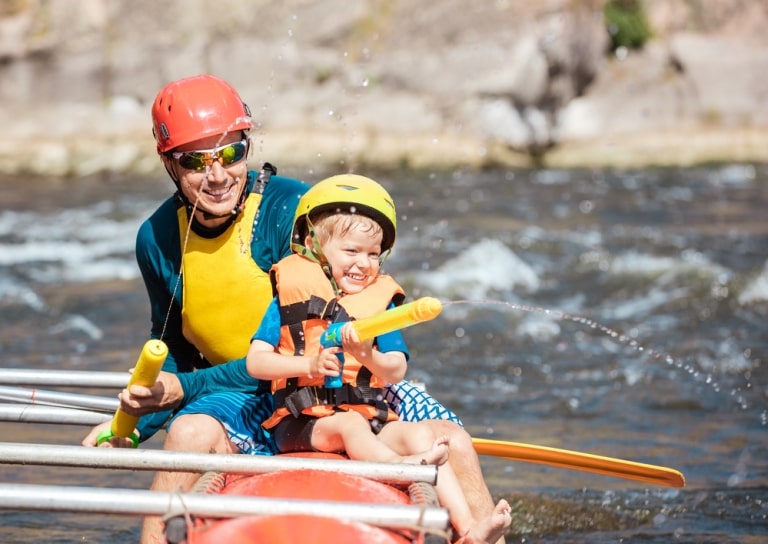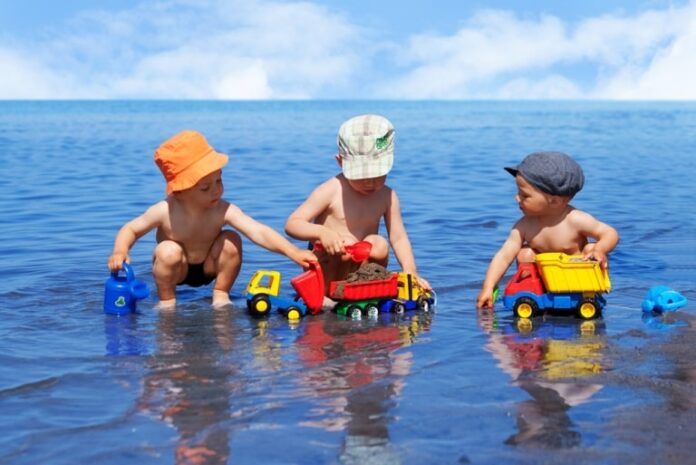Embarking on water-based adventures with your kids can create memories that last a lifetime. However, ensuring their safety and enjoyment requires a bit of forethought and planning.
In this blog post, we’ll explore the essential steps for preparing your kids for water activities while traveling. From choosing the right gear to teaching necessary skills and safety protocols, we’ll guide you through how to make your next aquatic adventure with your little ones safe, fun, and unforgettable.
Make Sure They Can Swim Well
Before you dive into any water activities, it’s crucial to ensure that your kids can swim well. Even if lifeguards are present, or if the activities seem relatively safe, strong swimming abilities are a must.
Enroll them in swim lessons before your trip, or if you’re short on time, offer them intensive lessons leading up to the departure date. Don’t forget to practice with them in a variety of environments and conditions to ensure they are comfortable and confident in the water.
Essential Gear
Equipping your kids with the right gear is imperative to their safety and enjoyment. Start with a well-fitted, approved personal flotation device (PFD) that is appropriate for their weight and water activity. You can often rent these at your destination, but bringing your own ensures a proper fit.
Water shoes can protect their feet from sharp objects and rough surfaces, and a wetsuit or rash guard can provide warmth and sun protection. Don’t forget accessories like waterproof sunscreen, hats, and sunglasses.
Lastly, pack a waterproof bag to keep their clothes and other essentials dry. Always double-check the gear before heading out for the day’s adventure.
Selecting Appropriate Swimwear for Kids
Choosing the right swimwear for your kids is more than just about aesthetics, it’s a matter of comfort, safety, and protection. Opt for swimwear made from high-quality, durable, and quick-drying materials that can withstand the rigors of active play in water. Look for features like a UPF rating, which indicates the level of sun protection the garment provides.
Swimwear with UPF 50+ rating offers excellent protection against harmful UV rays. Ensure that the swimsuit fits well; it should be snug but not too tight, allowing ample freedom for movement. For girls, one-piece suits or tankinis offer good coverage while board shorts and rash guards are great for boys.
In cooler climates or for prolonged water exposure, consider thermal swimwear or wetsuits to help maintain body temperature. Bright and vibrant colors or fun patterns can make it easier for you to spot your child in a crowd or the water.
Sun Protection for Fun in the Sun
Sun protection is a critical component of ensuring your kids enjoy their water activities safely. High exposure to sunlight, especially during peak hours, can put your child at risk for sunburns and long-term skin damage.
Start by applying a broad-spectrum, water-resistant sunscreen with an SPF of at least 30 to their skin, and reapply every two hours or immediately after they’ve been in the water.
Hats with wide brims can shield their face, ears, and neck from the sun, while sunglasses with 100% UV protection can safeguard their eyes. Consider setting up a shade tent or beach umbrella where they can take breaks from direct sunlight.
Remember, the best sun protection is a combination of shade, clothing, and sunscreen. It’s also crucial to keep them hydrated with plenty of water throughout their water escapades.
Creating a Water Safety Plan

Creating a water safety plan is a key step in preparing your kids for water activities while traveling. This plan should include understanding the water conditions of your destination, teaching your children how to recognize potential hazards, and equipping them with basic rescue techniques.
- Understanding Water Conditions: Familiarize yourself with the specific water conditions and potential risks at your destination. This can include currents, tides, and the presence of marine wildlife. Provide this information to your children in an age-appropriate manner to make them aware of what they might encounter.
- Recognizing Hazards: Teach your children to identify potential water hazards, such as deep water, strong currents, or dangerous marine life. Establish clear rules about where they can play and swim, and ensure they understand the importance of staying within designated swimming areas.
- Basic Rescue Techniques: While we hope it never comes to it, kids must know what to do in an emergency. Teach them basic rescue techniques like floating on their back, signaling for help, and the importance of not attempting to personally rescue someone, but instead alerting a lifeguard or an adult.
You should also establish check-in times and make sure your kids understand the importance of checking in with you regularly, especially if they are playing in the water without adult supervision.
Your water safety plan should be discussed as a family to ensure everyone understands the protocols, increasing the safety and enjoyment of your water activities.
Identifying Safe Water Environments for Kids
Choosing the right water environment for your kids’ activities is fundamental to their safety and enjoyment. Opt for locations with lifeguards on duty whenever possible, as they are trained to spot potential hazards and respond quickly in case of emergency.
Public pools, supervised beaches, and water parks usually offer a controlled environment that is suitable for children.
Consider the water’s depth and clarity as well. Shallow, clear water allows kids to see what’s beneath them, potentially avoiding any underwater hazards. Conversely, avoid areas with murky water, strong currents, or sudden drop-offs.
In natural settings, it’s essential to be aware of the local wildlife. Some areas may be home to harmful marine creatures such as jellyfish, sharp-shelled animals, or even sharks. Conduct thorough research or consult with local authorities before letting your kids play in these waters.
No environment is entirely risk-free, so it’s always important to supervise your kids closely, regardless of where they are swimming. Teach them to respect the water and to understand that conditions can change rapidly, especially in the ocean or large lakes.
With the right preparation and awareness, water activities can be both safe and incredibly fun for kids.Water activities can be an exciting and memorable part of traveling with your kids.
By ensuring they have strong swimming skills, appropriate gear, proper sun protection, a safety plan, and selecting suitable water environments, you can minimize the risks and maximize the enjoyment for everyone involved.
With these essential steps in mind, get ready to make unforgettable memories on your next water adventure with your little ones!
